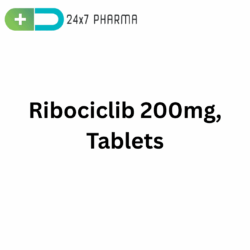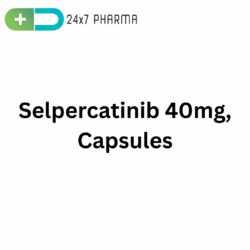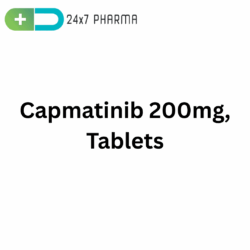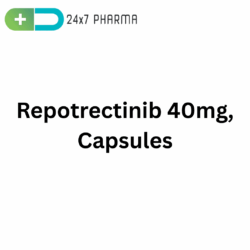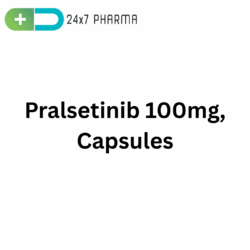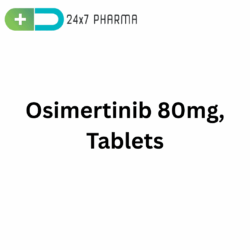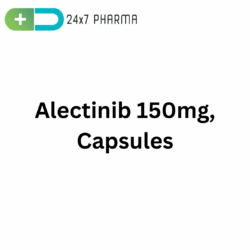LuciRit 50mg, Ritlectinib Capsules
Ritlectinib, a new experimental medication that falls under the class of selective ROS1/NTRK inhibitors, is a component of the targeted cancer treatment LuciRit 50mg. Designed for precision oncology, LuciRit targets genetic mutations found in specific tumors, making it an innovative choice in personalized cancer treatment. It is developed to treat patients with certain types of advanced or metastatic cancers, especially non-small cell lung cancer (NSCLC) that exhibits ROS1 gene rearrangements.
What is LuciRit 50mg?
LuciRit 50mg (Ritlectinib) is an oral targeted therapy drug developed to inhibit ROS1 and NTRK gene fusions in cancer cells. These gene fusions result in uncontrolled cell proliferation and tumor growth. Ritlectinib blocks these abnormal signaling pathways, thereby inhibiting tumor growth and spread. It is a selective, potent, and brain-penetrant tyrosine kinase inhibitor (TKI), effective in both systemic and intracranial disease.
How It Works / Mechanism of Action
- Ritlectinib acts as a tyrosine kinase inhibitor (TKI) specifically designed to target: ROS1 (c-ros oncogene 1)
- Tropomyosin receptor kinases, or TRK family of receptors (NRK1, NTRK2, and NTRK3)
Gene-fused tumors have aberrant activation of these receptors. Ritlectinib selectively binds to the ATP-binding pocket of the kinase domain of these fusion proteins and inhibits phosphorylation, which stops downstream signaling pathways like MAPK/ERK and PI3K/AKT—key drivers of cancer cell survival, proliferation, and metastasis. This leads to apoptosis (programmed cell death) and reduction in tumor burden.
How to Use / Indications
LuciRit 50mg is primarily indicated for:
- ROS1-positive metastatic non-small cell lung cancer (NSCLC)
- NTRK fusion-positive solid tumors (under clinical trials)
It may also be considered for cancers resistant to other ROS1 inhibitors like crizotinib, where Ritlectinib shows effectiveness against resistance mutations. This drug is typically prescribed after confirmation of gene fusions through next-generation sequencing (NGS) or FISH testing.
How to Take / Dosage
Recommended Dosage:
- The standard adult dose is Ritlectinib 50mg orally once or twice daily, based on physician discretion, body weight, and response.
Administration Instructions:
- Take with or without food.
- Swallow the tablet whole with water.
- Avoid crushing, chewing, or splitting.
- Take the medicine at the same time every day.
Other Dosage Forms / Strengths
LuciRit 100mg (for titration or dose adjustment) Investigational pediatric doses under clinical trials
Dose Adjustments May Be Required:
- In cases of liver or kidney impairment
- When combined with strong CYP3A4 inhibitors or inducers
- If adverse reactions or drug toxicity occur
Side Effects
Common side effects include:
- Fatigue
- Constipation
- Nausea and vomiting
- Dizziness
- Diarrhea
- Increased liver enzymes (ALT, AST)
- Vision disturbances
Serious adverse effects:
- Hepatotoxicity (liver damage)
- QT prolongation (irregular heartbeat)
- CNS effects (headache, seizures)
- Myalgia or muscle weakness
- Pneumonitis (rare)
- Regular monitoring of liver function, ECG, and neurological status is recommended during treatment.
Storage
- Store below 25°C (77°F) in a dry place.
- Protect from moisture and direct sunlight.
- Keep out of reach of children.
- Do not use expired medication or tablets with visible defects.
Benefits
- Targeted Therapy: Selectively attacks cancer cells with minimal effect on healthy tissues.
- Effective in CNS Metastases: Crosses the blood-brain barrier and helps control brain lesions.
- Overcomes Resistance: Active against ROS1 mutations resistant to first-line inhibitors.
- Easy Oral Administration: IV chemotherapy does not require hospital stays.
- Improved Quality of Life: Due to fewer side effects and better tumor control.
Prescription
- LuciRit 50mg is a prescription-only medicine.
- It should be prescribed by an oncologist or specialist with experience in targeted therapies.
- Mandatory biomarker testing (ROS1/NTRK fusion confirmation) is needed before initiation.
- Dosing adjustments should be based on individual tolerance, hepatic function, and interaction risk.
Interactions
Ritlectinib is metabolized primarily via CYP3A4 enzymes. Drug interactions to watch for:
Avoid Co-administration With:
- Strong CYP3A4 inhibitors (e.g., ketoconazole, itraconazole) → may increase toxicity
- CYP3A4 inducers (e.g., rifampin, carbamazepine) → may reduce efficacy
- QT-prolonging agents (e.g., amiodarone, some antipsychotics)
- Antacids or proton-pump inhibitors may affect absorption
Caution With:
- Warfarin (monitor INR)
- Antiepileptic drugs
- Statins (risk of myopathy)
- Always inform your doctor of all current medications before starting LuciRit.
FAQs
What is LuciRit 50mg use for?
Used to treat ROS1-positive NSCLC and NTRK fusion-positive tumors.
How long should I take Ritlectinib?
Until disease progression or unacceptable toxicity.
Can it treat brain metastases?
Yes. It is designe to be effective against CNS disease.
Is monitoring required?
Yes—liver function, ECG, and periodic imaging.
Conclusion
LuciRit 50mg (Ritlectinib) represents a significant step forward in precision oncology. Its targeted action against ROS1 and NTRK fusion-positive cancers offers a powerful and selective treatment with relatively manageable side effects. Especially promising in NSCLC and solid tumors with gene rearrangements, Ritlectinib shows efficacy even in patients who have failed earlier ROS1-targeted therapies. In the rapidly changing field of individualized cancer treatment, LuciRit is showing promise due to its oral convenience, CNS activity, and capacity to overcome medication resistance.
Patients considering LuciRit should consult their oncologist for eligibility based on molecular profiling and discuss potential risks, benefits, and monitoring needs.


